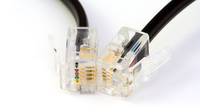
The telephone was created through the cross-pollination of two fileds of study - electricity and acoustics. The telephone operates on simple principles. A telephone mouthpiece contains a thin metallic coating separated from an electrode by a thin barrier (today we use plastic), which connects to a wire carrying an electric current. When a person speaks into the mouthpiece, the acoustic vibrations from the speech push the metallic coating slightly closer to the electrode, resulting in variations in voltage and therefore a speedy conversion from acoustic to electric energy. The electric pulses are conveyed through a wire to the speaker on the other end, where electric pulses are converted into acoustic energy again.
Converting speech to electrical energy before transmission is far more efficient than conveying speech through a mechanical channel, for example a metal pipe, because the walls of mechanical channels absorb so much of the acoustic energy as it travels. Well-insulated wires, however, are effective at protecting electrical energy from dispersing before reaching its destination. Electrical pulses travel at the speed of light, whereas acoustic pulses are limited by the speed of sound.


















